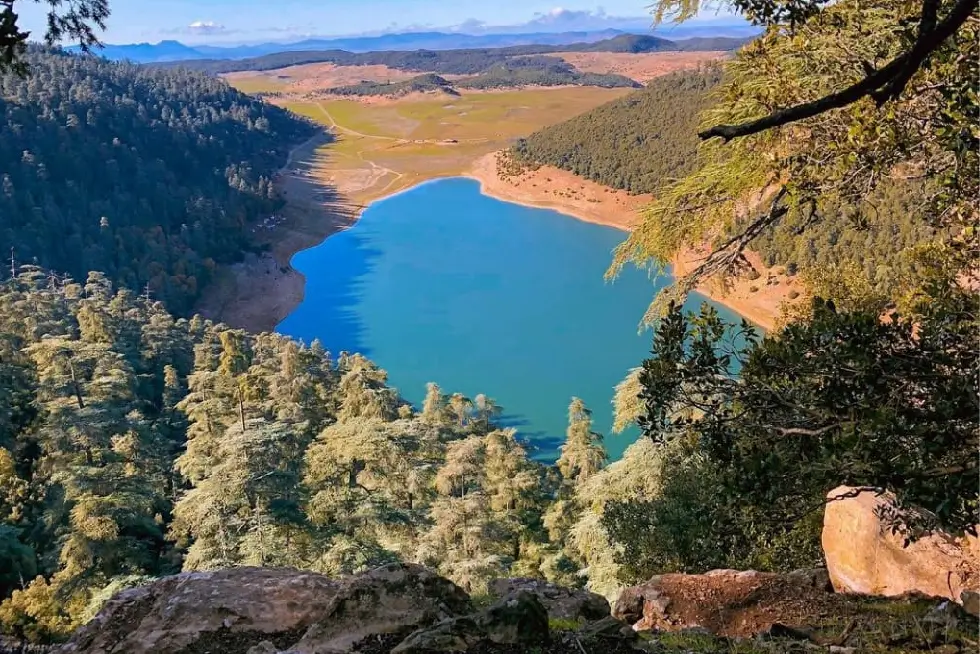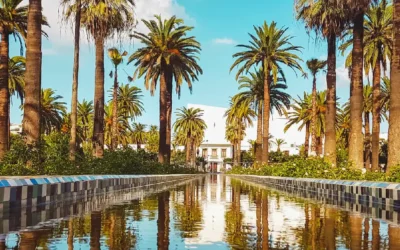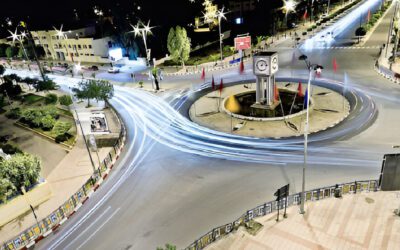Khenifra: A City in Morocco Where Oum Er-Rbia River Meets The Atlas Mountains

Table of Contents:
Introduction To Khenifra City
Khenifra is a city nestled in the heart of central Morocco in the Beni Mellal-Khenifra region. The city is marked by its strategic position within the western foothills of the southern Middle Atlas mountains.
This city, sitting at approximately 3,280 feet above sea level, is cradled by the banks of the Oum Er-Rbia River, making it a pivotal location historically and ecologically.
Originally serving as the winter headquarters for the Aït Affi, a faction of the local Zaian Amazigh (Berber) nomads.
Khenifra thrives with Tamazight-speaking Amazigh people, known for their exceptional equestrian skills, who harmoniously blend traditional herding with agriculture in the mountains.
The city’s name echoes the legacy of an ancient shepherd, Khanfar, symbolizing a deep bond with the land.
The surrounding landscapes, like the serene Arougou and the biodiverse Agelmam Azegza Lake, offer a canvas of natural beauty.
Khenifra Discovery Tour
Khenifra is a treasure trove of history and natural wonders to discover and explore. Here’s a guide to the must-visit spots in this captivating city.
A. Nature’s Paradise
1. Aguelmam Azigza National Park
Dive into the heart of nature with the park’s lush forests and scenic walking trails. It’s a haven for nature lovers craving tranquility and beauty.
2. Arougou
Known for its stunning vistas, Arougou sits elegantly by the Oum Errabia River, encased by lakes and thick forests. It’s a year-round sanctuary, perfect for those seeking peace in nature’s lap.
B. Historical Elegance
Agelmam Azegza Lake
More than just a lake, this site is steeped in history and part of vital conservation efforts. Surrounded by oak and cedar, it sits proudly at 1470 meters, offering more than just views but a journey into the region’s soul.
C. Cultural Heartbeat
The Medina
Though smaller than its famous counterparts in Fez or Marrakesh, Khenifra’s Medina pulsates with life, showcasing traditional crafts and vibrant market scenes. It’s a cultural immersion into the Moroccan way of life.
Khenifra Accessibility And Transportation
Khenifra, surrounded by the Majestic Atlas Mountains and gently touched by the serene Oum Er-Rbia River, holds a prime spot in the heart of Morocco. Its lifeline, National Highway 8, forges vital connections to bustling Marrakech and historic Fes.
This arterial road is the backbone of Khenifra’s travel network, offering seamless access for both the local populace and adventurous travelers, thereby invigorating the city’s pulse and its economic prospects.
Navigating Khenifra: A Tapestry of Transport Options
Within the city’s embrace, a diverse array of transport means weaves through the streets, mirroring the city’s dynamic urban fabric.
Although specifics are scant, the essence of Khenifra’s mobility resonates with the Moroccan tradition of blending public and private transit solutions.
1. Public Transit: The Heartbeat of Urban Life
Buses and taxis, the city’s circulatory system, pulse through Khenifra, linking vibrant markets, peaceful residential areas, and the hum of commercial life.
The intimate dance of petit and grand taxis offers a more tailored journey, allowing for an exploration of the city’s nooks and crannies with ease and personal touch.
2. The Charm of Non-Motorized Travel
In the denser or historic quarters, the rhythm of life slows, inviting pedestrians and cyclists to savor the city’s rich tapestry at their own pace.
This eco-friendly approach not only nurtures the environment but also fosters a deeper connection with Khenifra’s lively streets and cultural heartbeat.
3. Private Vehicles: Exploring at Will
For those steering their course, Khenifra’s roads accommodate a personal exploration via car or motorcycle, with thoroughfares artfully draped across the city’s varied terrain.
The city’s roads, designed with the mountainous landscape in mind, promise a journey as scenic as the destination itself.
Modern Khenifra And Its Economic Significance
1. Khenifra’s Transformation Journey
Khenifra, nestled within Morocco’s Beni Mellal-Khenifra region, is on a vibrant path toward socio-economic renewal.
The city is embracing its rich agricultural heritage and untapped tourism and mining potentials to overcome challenges such as poverty, youth unemployment, and gender disparities in workforce participation.
2. Spearheading Change: The ISED-BMK Project
At the heart of this transformation is the Morocco Inclusive Socioeconomic Development in Beni Mellal-Khenifra (ISED-BMK) initiative, powered by USAID.
This project is not just about growth; it’s about equitable, sustainable progress that reaches every corner of the community.
3. A Collaborative Blueprint for Progress
ISED-BMK is a masterclass in collaboration and innovation, focusing on gender inclusivity and private-sector dynamism. It aims to catalyze inclusive economic growth, enhance governance, and empower civil society, ensuring that growth is not just rapid but also broad-based and inclusive.
4. Vision 2025: A Brighter Future for All
The project’s vision for 2025 is clear: a more inclusive, prosperous Khenifra where opportunities abound for all, especially the marginalized.
It’s about closing gaps in income, skills, and access, ensuring everyone can partake in the region’s prosperity.
5. United for Khenifra
Leading this charge is FHI 360, alongside local champions like AIDECA, symbolizing a unified effort to reshape Khenifra’s socio-economic landscape, in alignment with Morocco’s national development goals.
This initiative represents a beacon of hope for Khenifra, showcasing what’s possible when communities, governments, and international partners join hands for a common cause.
Khenifra History Overview
A. The Heart of Berber Tradition and Strategic Might
Khenifra, a city bathed in history, stands as a testament to Morocco’s rich cultural tapestry. At its core, the city thrives on its Berber roots and strategic military significance, intertwined with abundant natural resources.
This central Moroccan city has been a stronghold of the Zayanes tribe, shaping its identity for centuries.
B. Pivotal Battles and Colonial Encounters
The city’s strategic value shone brightly during the Zaian War. In 1914, French General Paul Prosper Henrys set his sights on Khenifra, a move that would forever alter its historical course. This event underscored Khenifra’s military relevance, marking a crucial chapter in its annals.
C. Foundations of Strength and Independence
Tracing back to 1688, Khenifra’s establishment was a calculated move by ʿAlawī sultan Mawlāy Ismāʿīl. He fortified the area with a robust casbah and a bridge, laying the groundwork for its future.
By the late 19th century, under the leadership of Muha ū Hāmū al-Zaiyānī, Khenifra declared its autonomy, bolstered by a new market and urban development, further elevating its regional stature.
D. Colonial Struggles and Enduring Heritage
The French occupation in 1914, culminating in full control by 1921, was a watershed in Khenifra’s history, blending local resistance with colonial dynamics.
Yet, despite such turmoil, the city’s soul remains deeply entrenched in its Berber heritage, visible in the Tamazight-speaking, seminomadic Zaian Amazigh communities, renowned for their equestrian skills and traditional way of life.
Conclusion
As we draw the curtain on our journey through Khenifra, we carry with us the echoes of its rich traditions and the serene beauty of its mountainous embrace.
This Moroccan gem, tucked away in the Atlas, leaves an indelible mark on the heart, beckoning for a return to its enchanting realms.
FAQ
What is Khenifra?
Khenifra is a city in central Morocco, within the Béni Mellal-Khénifra region, situated in the western foothills of the southern Middle Atlas mountains.
What is Aguelmam Azigza National Park?
The park offers lush forests, walking trails, and a tranquil environment for nature enthusiasts.
What is Khenifra is known for?
Khenifra is known for its historical and ecological significance, is located by the Oum Er-Rbia River, and is a hub for Berber culture and natural landscapes.
What are Khenifra’s main attractions?
Attractions include Aguelmam Azigza National Park, Arougou’s vistas, Agelmam Azegza Lake, and the vibrant Medina.
How can you reach Khenifra?
Accessible via National Highway 8, Khenifra is well-connected to Marrakech and Fès, with the Atlas Mountains and the Oum Er-Rbia River enhancing its accessibility.
What transportation options are in Khenifra?
Transportation includes buses, taxis, and private vehicles, with walking and cycling popular in historic areas.
What’s the economic focus of Khenifra?
Khenifra focuses on agriculture, tourism, and mining for economic renewal, supported by projects like ISED-BMK for inclusive growth and improved governance.
What aims does the ISED-BMK project have?
The ISED-BMK project aims for economic growth, better governance, and a vibrant civil society, targeting a prosperous Khenifra by 2025.
What impact did the French occupation have on Khenifra?
The French occupation, from 1914 to full control by 1921, introduced colonial dynamics but Khenifra preserved its Berber culture and traditions.



